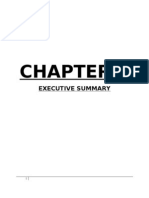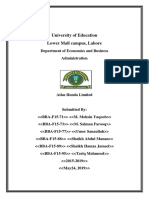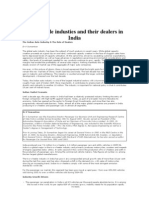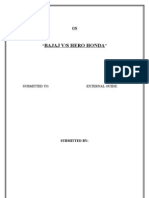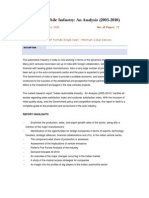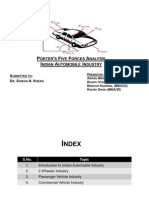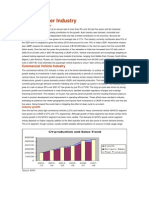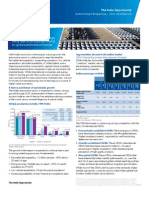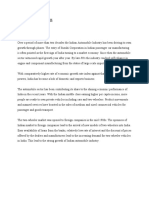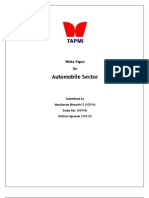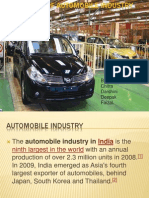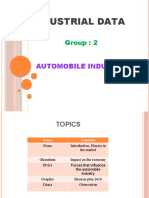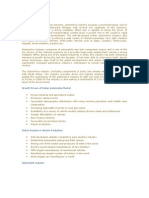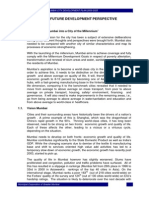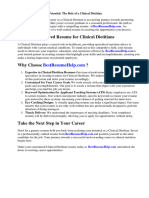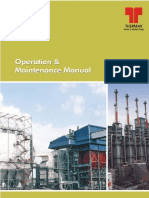Medium & Heavy Commercial Vehicles' Industry: An Overview: Group Members
Medium & Heavy Commercial Vehicles' Industry: An Overview: Group Members
Uploaded by
krunalpshahCopyright:
Available Formats
Medium & Heavy Commercial Vehicles' Industry: An Overview: Group Members
Medium & Heavy Commercial Vehicles' Industry: An Overview: Group Members
Uploaded by
krunalpshahOriginal Title
Copyright
Available Formats
Share this document
Did you find this document useful?
Is this content inappropriate?
Copyright:
Available Formats
Medium & Heavy Commercial Vehicles' Industry: An Overview: Group Members
Medium & Heavy Commercial Vehicles' Industry: An Overview: Group Members
Uploaded by
krunalpshahCopyright:
Available Formats
MEDIUM & HEAVY COMMERCIAL VEHICLES INDUSTRY: AN OVERVIEW
GROUP NUMBER: 7
GROUP MEMBERS:
1. PRANSHU GUPTA 2. DEEPTI KANAL 3. MANISH KESHARI 4. AZAM ALI KHAN 5. RICHA KHETAWAT 6. MEENU MAHESHWARI 7. MILIND RAWAT (119) (122) (123) (124) (125) (130) (143) DATED: 12TH SEPTEMBER 2007
CONTENTS
1. 2. 3. 4. 5. 6. 7. 8. 9.
Abstract....3 Introduction ... 4 Classification of Commercial Vehicles..... 4 Size of Industry.......... 5 Market Share of Various Players .....6 Growth Enablers ....7 Key Problem Area.. ...8 Road Ahead.....9 Conclusion...9
10. References.....10
ABSTRACT
With the economy growing at an astounding rate of more than 9% a year, the transportation industry is growing at a similar pace. With easing of various norms & regulations for foreign investors to invest money in India, technological improvements have been phenomenal. India is the fourth largest Commercial Vehicle market of the world. The major players being Tata Motors & Ashok Leyland holding a total market share of approx. 91 %. With lots of Improvements & developments in the Infrastructural projects, the demand for Heavy commercial vehicles has seen a spurt .Though; the industry is facing a severe competition from Railways which is a cheaper mode of transport comparatively.
INTRODUCTION
The Indian CV industry is the fourth largest in the world with major players being Tata 3
Motors, Ashok Leyland, Mahindra and Mahindra , Eicher and Swaraj Mazda. It grew by 33% in FY07 compared to FY06 (Source:INDIA INFOLINE)
MAJOR CLASSIFICATIONS OF COMMERCIAL VEHICLES IN INDIA
COMMERCIAL VEHICLES (BASED ON GVW)
MEDIUM & HEAVY COMMERCIAL VEHICLES > 11 tonnes GVW
LIGHT COMMERCIAL VEHICLES 2 10 tonnes GVW
SMALL COMMERCIAL VEHICLES 1-2 tonnes
COMMERCIAL VEHICLES BASED ON TYPES OF VEHICLES
GOODS
PASSENGER S
RIGID TRUCKS
TRACTOR TRAILERS
TIPPERS
PICK UPS
APPLICATION BASED
TRANSIT MIXER BULKERS FUEL TANKERS
BUSES
SIZE OF AUTOMOBILE INDUSTRY IN INDIA(2006-07)
The domestic automobile market in India saw a 13.5% growth in the fiscal 2006-07 on a year on year basis over 2005-06. The total domestic sales for the year stood at 1,01,09,037. The sales for the commercial vehicles stood at 4,67,882 units.
MAJOR PLAYERS IN THE FIELD OF HCV: Tata Motors
Established in 1945, is the leader in the Commercial Vehicles segment and no. 2 in the passenger car market. It is the world's fifth-largest M&HCV manufacturer. Tata Motorss product range covers passenger cars, multi-utility vehicles as well as LCV, M&HCV for goods and passenger transport.
Ashok Leyland
Established in 1948, Ashok Motors was set up in Madras for the assembly of Austin Cars. In 1955 with equity participation by British Leyland, the Company's name changed to Ashok Leyland. Since then it has been a major player in India's commercial vehicle industry.
Volvo Motors
Founded in 1927, Volvo is one of the worlds leading manufacturers of heavy commercial vehicles and diesel engines. Today, Volvo has approximately 81,000 employees and production in 25 countries and operates on more than 185 markets.
Eicher Motors
Founded in 1982, a part of Eicher Group. It manufactures and markets trucks, buses, automotive gears, motorcycle and deals with the exports vehicles, aggregate and components.
Force Motors
Founded in 1950, Force Motors Limited is an enterprise of the Firodia Group (formerly Bajaj Tempo Limited). Recently rolled out the MAN series of M&HCVs
Vehicle Factory Jabalpur
Vehicle Factory, Jabalpur established in 1969 is a dedicated manufacturing unit to meet 'Transport Needs' of the Armed Forces.
MARKET SHARE OF VARIOUS PLAYERS IN M&HCV SEGMENT:
The domestic market share of different players in MHCV is shown as under:
DOMESTIC MARKET SHARE MHCV 2006-07
OTHERS (VOLVO, SCANIA, MAN, ACTROS) 8% TATA MOTORS 63%
ASHOK LEYLAND 28%
EICHER 1%
GROWTH TREND OF M&HCV IN INDIA
246857
Exports of M&HCV form a minimal portion. Mainly two players are into exports of M&HCV. Tata Motors exported 12155 units and Ashok Leyland exported 6358 units in the year 2006-07
136804 95741 73185
28 12 7 28 69 2
172868
179345
19 97 0
24 59 1
25 63 8
16 81 4
PASSENGERS RS GOODS
'01-02
'02-03
'03-04
'04-05
'05-06
'06-07
[SOURCE: SIAM] Six years of consecutive growth in the MHCV segment of commercial vehicles has been observed in India
GROWTH ENABLERS OF M&HCV INDUSTRY:
There are various factors which are contributing to the growth & development of M & HCV Industry in a big way .Some of them are as follows :
Market Induced Factors
Robust GDP(9.4%) and IIP (11.3%) growth in 2006-07 Freight generating sectors registered robust growth High demand potential replacements with stricter emission norms in offing Favorable demandsupply scenario with buoyant freight outlook Increasing capacity utilization in road freight industry. Introduction of more economical and fuel -efficient vehicles Improved profitability of fleet operators coupled with shrinking replacement cycle for CVs
Strong economic activity in the country, leads to increased demand for freight movement by road. Continued strength in freight rates in the last 12 -15 months (up ~5%) and the 12% cut in fuel prices since Nov -06 have adequately compensated for increased cost pressures owing to inflation and rise in interest rates
Govt. Policy Induced Factors
Strict implementation of Overloading ban means increased volumes Infrastructure development continued to gain momentum o NHAI project completion : 26% o NHDP Phase V 6,500 Kms included Favorable regulatory environment such as changes in emission norms, (BS-III norms implemented in 11 major industrial cities of India from April 2005) strict restrictions imposed by cities on vehicle age (No MHCV of 8 years or older can ply on Mumbai) Proposed phase-out of CST by 2010 will boost the organized logistics players and in turn the CV manufacture Weighted tax deduction of upto 150% for in-house research and R&D activities. (Auto Policy 2002) Now 100% foreign equity investment is allowed by the government and does not lay down any minimum investment criterion (Auto Policy 2002)
KEY PROBLEM AREAS
Market Induced Factors
Inflationary pressures and likely interest rate hikes Input Costs are expected to continue to pose a key challenge Crude Oil price trends need to be watched closely Competition from airline and railway industry.
Emergence of stricter international norms like ELV (end-of-life vehicle) will cause obsolescence of established current manufacturing procedures.
Govt. Policy Induced Factors
Increase in competitive intensity by the entry of international players like Man and Scania. This will pose a challenge to Indian players like Tata and Ashok Leyland. Certain markets like coal, cement & steel are captive for railways by govt. regulations
THE ROAD AHEAD
With technologically advanced global players vying to enter Indian markets for both manufacturing and research, the sector is bound to grow while also making its presence felt in the international arena.
New Trends in Industry
Super Heavy Commercial Vehicles 40T GVW and above (Benz Actros, Tata Novus, Tatra, Scania) HYBRID Trucks (Ashok Leyland) GPS Controlled Vehicles & freight Tracking Systems. Percolation of latest technology from car segment to HCV. Shift towards structured & large Fleet Operators.
CONCLUSION
The Commercial Vehicle market has in the past shown a cyclic trend, as , it has faced a downturn in 1995-96 and 2000-01, & a similar recession can be expected in the near future. Usually, this is because of excess capacity buildup & a slight correction in demand recently in the first quarter of present fiscal. At the same time the economy is surging ahead at a healthy growth rate and there is a lot of untapped market hitherto a domain of railways which could be tapped into and not to mention the export segment. These factors may help in avoiding the downturn that is possible in short term. Certain factors that might pose a
problem in short term are increasing interest rates for financing, and need for higher expenditure on R&D to meet the environmental norms and competition. These might be offsetted by the deep penetration achieved by finance firms & booming economy and the tax sops on R&D. The overcapacity issue though can become a major one, but will also enable to meet the export sector All in all it can be said that the short term period is of caution but in the long term, the market is expected to grow well despite the expected revival of Railways.
REFERENCES
www.siam.in www.icra.org www.tatamotors.com www.eicherworld.com www.ashokleyland.com www.ibef.org www.cso.org www.unionbudget.nic.in www.north.nic.in www.economictimes.com www.commerce.nic.in www.elvsolutions.org www.automartindia.com www.indiainfonline.com
10
You might also like
- Procurement 2023 SKK MIGASDocument37 pagesProcurement 2023 SKK MIGASRama Yolanda100% (2)
- Ashok Leyland MultiDocument119 pagesAshok Leyland Multibaranimba5100% (3)
- Marketing Strategy of Maruti SuzukiDocument87 pagesMarketing Strategy of Maruti SuzukiSaurabh Lohal82% (17)
- Normative EthicsDocument9 pagesNormative EthicskrunalpshahNo ratings yet
- Portfolio Analysis Commercial VehiclesDocument25 pagesPortfolio Analysis Commercial Vehiclesroguemba100% (1)
- Business Analysis of Auto IndusrtyDocument29 pagesBusiness Analysis of Auto IndusrtySaurabh Ambaselkar100% (1)
- VANSHIKA Industry Overview - Automobile - DraftDocument18 pagesVANSHIKA Industry Overview - Automobile - DraftKinshuk AcharyaNo ratings yet
- Shutiya BnoingDocument4 pagesShutiya BnoingVM MonuNo ratings yet
- Changes in The Marketing Strategies of Automobile Sector Due To RecessionDocument102 pagesChanges in The Marketing Strategies of Automobile Sector Due To RecessionVivek SinghNo ratings yet
- Tata Motors Analysis PDF NewDocument23 pagesTata Motors Analysis PDF NewAlay Desai73% (11)
- Customer SatisfactionDocument62 pagesCustomer SatisfactionharishNo ratings yet
- Project On Tvs Vs BajajDocument63 pagesProject On Tvs Vs BajajSk Rabiul Islam100% (1)
- Automobiles Industry ReportDocument5 pagesAutomobiles Industry ReportvaasurastogiNo ratings yet
- Auto Component Sector Report: Driving Out of Uncertain TimesDocument24 pagesAuto Component Sector Report: Driving Out of Uncertain TimesAshwani PasrichaNo ratings yet
- University of Education Lower Mall Campus, LahoreDocument27 pagesUniversity of Education Lower Mall Campus, LahoreSeemab Sheikh QurashiNo ratings yet
- Industry AnalysisDocument6 pagesIndustry AnalysisMichael SapriioNo ratings yet
- Tvs ReportDocument62 pagesTvs ReportvipinkathpalNo ratings yet
- A Study On Customer Satisfaction Towards Bajaj Pulsar With Special Reference To Wasan Bajaj, NashikDocument46 pagesA Study On Customer Satisfaction Towards Bajaj Pulsar With Special Reference To Wasan Bajaj, NashikMayurNo ratings yet
- Automobile Industies IndiaDocument4 pagesAutomobile Industies IndiaSharath RaoNo ratings yet
- JBMDocument53 pagesJBMVaibhav Ahlawat100% (1)
- BAJAJ Vs HERO HONDA Comparative Analysis in Automobile Industry Thesis 86p.Document88 pagesBAJAJ Vs HERO HONDA Comparative Analysis in Automobile Industry Thesis 86p.Chandani Thakur100% (1)
- India AnalysisDocument5 pagesIndia AnalysisKeshav JayantNo ratings yet
- 08 Ashok LeylandDocument18 pages08 Ashok Leylandkohinoor_roy5447No ratings yet
- Automobile Industry: Presented To: Mr. Afaq Ali KhanDocument36 pagesAutomobile Industry: Presented To: Mr. Afaq Ali KhanhelperforeuNo ratings yet
- Porter's Five Forces Analysis - Indian Automobile Industry 2Document60 pagesPorter's Five Forces Analysis - Indian Automobile Industry 2Ashish Mendiratta50% (2)
- Auto MobileDocument44 pagesAuto MobileSanjay PatelNo ratings yet
- Automobile Industry in India - Marketing ChallengesDocument21 pagesAutomobile Industry in India - Marketing ChallengesAnkit VermaNo ratings yet
- Automotive SectorDocument13 pagesAutomotive SectorachalconstNo ratings yet
- Automotive Perspective - 2012 and Beyond: The India OpportunityDocument2 pagesAutomotive Perspective - 2012 and Beyond: The India OpportunitySameer SamNo ratings yet
- An Outlook On Indian Two Wheeler IndustryDocument18 pagesAn Outlook On Indian Two Wheeler IndustryPankaj Goenka100% (1)
- Automobile: Industry AnalysisDocument21 pagesAutomobile: Industry AnalysisSwapn DeepNo ratings yet
- Sales Promotion and Requirement of Buses in School Eicher-MotorsDocument77 pagesSales Promotion and Requirement of Buses in School Eicher-MotorsBrijesh Kumar100% (1)
- Automobile MGM WhitepaperDocument16 pagesAutomobile MGM WhitepaperSudip KarNo ratings yet
- Fundamental and Technical Analysis of Automobile SectorDocument82 pagesFundamental and Technical Analysis of Automobile SectorAnant SharmaNo ratings yet
- Ashok Leyland: The Federation of UniversitiesDocument17 pagesAshok Leyland: The Federation of UniversitiesKunal AhiwaleNo ratings yet
- Analysis of Automobile IndustryDocument9 pagesAnalysis of Automobile IndustryNikhil Kakkar100% (1)
- A Presentation On "Landscape of Automobile Industry Sector": Consulting ClubDocument22 pagesA Presentation On "Landscape of Automobile Industry Sector": Consulting ClubaddyamitNo ratings yet
- Industry: Key Points Supply DemandDocument4 pagesIndustry: Key Points Supply DemandHarsh AgarwalNo ratings yet
- Automobile Car Industry OverviewDocument8 pagesAutomobile Car Industry OverviewsavaliyamaheshNo ratings yet
- Birla Institute of Technology and Science Pilani: Automobile Sector in IndiaDocument16 pagesBirla Institute of Technology and Science Pilani: Automobile Sector in Indiaਸਚਿਨ ਸੋਨੀNo ratings yet
- Auto Survey Report-12!1!10lDocument77 pagesAuto Survey Report-12!1!10lyudhie_7No ratings yet
- Automobile Sector-Two Wheeler SegmentDocument41 pagesAutomobile Sector-Two Wheeler SegmentSandhya UpadhyayNo ratings yet
- Industrial Data: Group: 2Document17 pagesIndustrial Data: Group: 2Elle7loboNo ratings yet
- Indian Auto IndustryDocument55 pagesIndian Auto IndustrySk Rabiul IslamNo ratings yet
- Automotive Industry OverviewDocument7 pagesAutomotive Industry OverviewAshim DuttaNo ratings yet
- Case Study Report - 22MBAB35Document50 pagesCase Study Report - 22MBAB35varshini vishakanNo ratings yet
- Auto Industry: Growth Drivers of Indian Automobile MarketDocument5 pagesAuto Industry: Growth Drivers of Indian Automobile Marketbipin3737No ratings yet
- AutomobileDocument17 pagesAutomobileIha BansalNo ratings yet
- Marketing Strategy of Bajaj AutomobilesDocument57 pagesMarketing Strategy of Bajaj AutomobilesShruti Das57% (7)
- ACA ReportDocument59 pagesACA Reportbhuvan mehraNo ratings yet
- Allwyn Nissan Group 8Document58 pagesAllwyn Nissan Group 8Jayesh VasavaNo ratings yet
- Industry Performance in 2012-13Document4 pagesIndustry Performance in 2012-13piusadrienNo ratings yet
- 5analysis of Automobile IndustryDocument37 pages5analysis of Automobile IndustryKevin JacobNo ratings yet
- AutomobileDocument60 pagesAutomobileSaifullah Tariq100% (1)
- PAK Suzuki Case StudyDocument15 pagesPAK Suzuki Case Studyzahranqv1No ratings yet
- The Indian Automobile Industry: Speeding Into The Future ?: Actes Du GERPISA N° 28 35Document14 pagesThe Indian Automobile Industry: Speeding Into The Future ?: Actes Du GERPISA N° 28 35abcNo ratings yet
- Enterprise Management Automobile Industry Business Cases: Renault Morocco, Tesla, Hyundai, TATA Motors, Daimler Mobility, ToyotaFrom EverandEnterprise Management Automobile Industry Business Cases: Renault Morocco, Tesla, Hyundai, TATA Motors, Daimler Mobility, ToyotaNo ratings yet
- From the Cradle to the Craze: China's Indigenous Automobile IndustryFrom EverandFrom the Cradle to the Craze: China's Indigenous Automobile IndustryNo ratings yet
- Policies to Support the Development of Indonesia’s Manufacturing Sector during 2020–2024: A Joint ADB–BAPPENAS ReportFrom EverandPolicies to Support the Development of Indonesia’s Manufacturing Sector during 2020–2024: A Joint ADB–BAPPENAS ReportNo ratings yet
- Plastic Identification CodeDocument2 pagesPlastic Identification CodekrunalpshahNo ratings yet
- Daily Audience Report For: (Date) : Udience Easurement and Nalytics LTDDocument8 pagesDaily Audience Report For: (Date) : Udience Easurement and Nalytics LTDkrunalpshahNo ratings yet
- India PAK Nov 07 Matches AnalysisDocument15 pagesIndia PAK Nov 07 Matches AnalysiskrunalpshahNo ratings yet
- Rural Media VehicleDocument10 pagesRural Media VehiclekrunalpshahNo ratings yet
- Book Review: 22 Immutable Laws of MarketingDocument3 pagesBook Review: 22 Immutable Laws of MarketingkrunalpshahNo ratings yet
- Health and Wellness of WaterDocument3 pagesHealth and Wellness of WaterkrunalpshahNo ratings yet
- The True Nature of Corporate CreativityDocument4 pagesThe True Nature of Corporate CreativitykrunalpshahNo ratings yet
- Mumbai2005 25Document27 pagesMumbai2005 25krunalpshahNo ratings yet
- Marketing Research Process: Step One: Define Marketing Problems and OpportunitiesDocument4 pagesMarketing Research Process: Step One: Define Marketing Problems and OpportunitieskrunalpshahNo ratings yet
- Looking For Growth Opportunities Through Segmentation: The Industrial Management Consulting (IMC) Case StudyDocument8 pagesLooking For Growth Opportunities Through Segmentation: The Industrial Management Consulting (IMC) Case StudykristokunsNo ratings yet
- Indian It Industry The Leap From Servicing To ConsultingDocument8 pagesIndian It Industry The Leap From Servicing To ConsultingkrunalpshahNo ratings yet
- Normative B EthDocument12 pagesNormative B EthkrunalpshahNo ratings yet
- ArbitrationDocument12 pagesArbitrationkrunalpshah100% (1)
- ArbitrationDocument12 pagesArbitrationkrunalpshah100% (1)
- ConflictDocument24 pagesConflictkrunalpshahNo ratings yet
- Trade Union: Presented by Kavita N. KhadseDocument9 pagesTrade Union: Presented by Kavita N. KhadsekrunalpshahNo ratings yet
- Email Marketing 1727081227734Document2 pagesEmail Marketing 1727081227734vijaybalapvt.ltdNo ratings yet
- BDOD - Getting From A To AI - WebDocument16 pagesBDOD - Getting From A To AI - WebHải NguyễnNo ratings yet
- New Methods For Switchgear - Test and AnalysisDocument3 pagesNew Methods For Switchgear - Test and AnalysisJNo ratings yet
- TeaseDocument28 pagesTeaseTomas Olsson60% (5)
- Silo - Tips Chartpilot 1100 The Ecdis Solution The Versatile Approved Ecdis Electronic Chart Display and Information SystemDocument8 pagesSilo - Tips Chartpilot 1100 The Ecdis Solution The Versatile Approved Ecdis Electronic Chart Display and Information Systemchikitos96No ratings yet
- MOCK TEST 2 Ôn ChuyênDocument8 pagesMOCK TEST 2 Ôn Chuyênkietruong375No ratings yet
- Accident EssayDocument2 pagesAccident EssayAtiqah Azmi100% (1)
- Physical Education and HealthDocument6 pagesPhysical Education and HealthMeldie Ann B. LeopoldoNo ratings yet
- Duct Dependent Lesions - PPSXDocument41 pagesDuct Dependent Lesions - PPSXSindujaNo ratings yet
- Introduction of EntrepreneurshipDocument12 pagesIntroduction of EntrepreneurshipLeigh IlustrisimoNo ratings yet
- EU Refinery Energy Systems and EfficiencyDocument34 pagesEU Refinery Energy Systems and EfficiencyvietnampetrochemicalNo ratings yet
- Clinical Dietitian Resume Cover LetterDocument6 pagesClinical Dietitian Resume Cover Lettere7dh8zb1100% (1)
- RECONCILATIONDocument3 pagesRECONCILATIONchandra shekharNo ratings yet
- Analysis of A Welding AccidentDocument7 pagesAnalysis of A Welding AccidentMario SanchoNo ratings yet
- HTML - FORMS - FRAMESDocument4 pagesHTML - FORMS - FRAMESBroaderNo ratings yet
- Gwich'in EthnobotanyDocument72 pagesGwich'in EthnobotanyNatalia Alexandra Bernal QuinteroNo ratings yet
- BL Chap 30Document6 pagesBL Chap 30Thanh Truc TruongNo ratings yet
- O M ManualDocument131 pagesO M Manualagniva dattaNo ratings yet
- Inguinal HerniasDocument24 pagesInguinal HerniasPatricia Oktaviani ANo ratings yet
- Dimetra PDFDocument51 pagesDimetra PDFSohaib Omer SalihNo ratings yet
- 251-270 Test Kits MCDocument20 pages251-270 Test Kits MCluis miguel huarita castellon100% (1)
- Grate KilnDocument8 pagesGrate KilnAnggiet HerdayantiNo ratings yet
- SM Lab 3Document15 pagesSM Lab 3Saimun MahumdNo ratings yet
- Loyalty: A Customer's Perspective: TH THDocument9 pagesLoyalty: A Customer's Perspective: TH THEmaNo ratings yet
- Katriona Torok, Kirtland School Board CandidateDocument2 pagesKatriona Torok, Kirtland School Board CandidateThe News-HeraldNo ratings yet
- Pretest EndocrineDocument2 pagesPretest EndocrineYuxin LiuNo ratings yet
- The Journal of Emergency MedicineDocument4 pagesThe Journal of Emergency MedicineTiara TarinaNo ratings yet
- PreviewpdfDocument72 pagesPreviewpdfSwaleha Akhtar50% (2)
- Anteproyecto de Ingles BásicaDocument14 pagesAnteproyecto de Ingles BásicaAna AdonNo ratings yet









